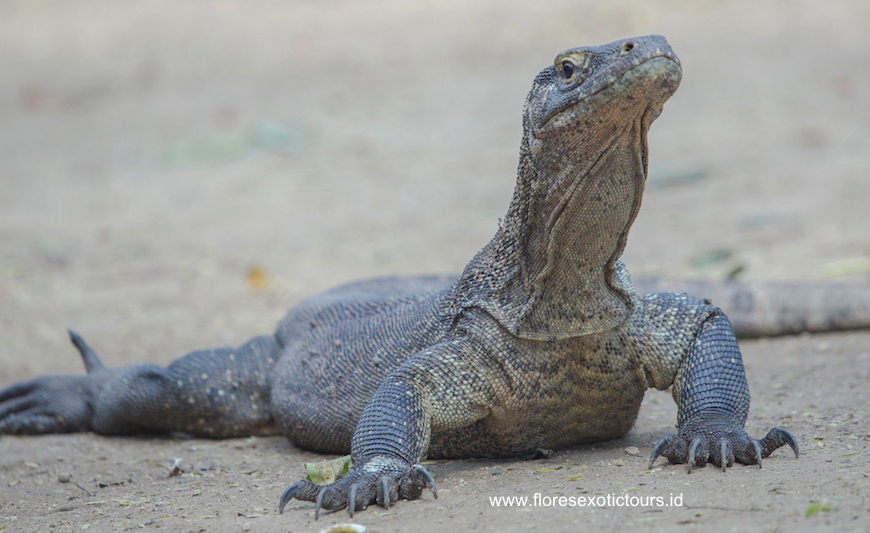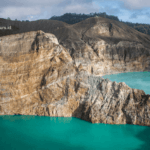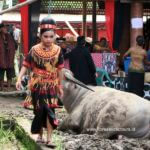Komodo National Park is located in the center of the Indonesian archipelago, between the islands of Sumbawa and Flores. Established in 1980, initially, the main purpose of the Park was to conserve the unique Komodo dragon (Varanus komodoensis) and its habitat. However, over the years, the goals for the Park have expanded to protecting its entire biodiversity, both terrestrial and marine. In 1986, the Park has declared a World Heritage Site and a Man and Biosphere Reserve by UNESCO, both indications of the Park’s biological importance.
Komodo National Park includes three major islands: Komodo, Rinca, and Padar, as well as numerous smaller islands creating a total surface area (marine and land) of 1817km (proposed extensions would bring the total surface area up to 2,321km2). As well as being home to the Komodo dragon, the Park provides refuge for many other notable terrestrial species such as the orange-footed scrub fowl, an endemic rat, and the Timor deer.
Moreover, the Park includes one of the richest marine environments including coral reefs, mangroves, seagrass beds, seamounts, and semi-enclosed bays. These habitats harbor more than 1,000 species of fish, some 260 species of reef-building coral, and 70 species of sponges. Dugong, sharks, manta rays, at least 14 species of whales, dolphins, and sea turtles also make Komodo National Park their home.
Threats to terrestrial biodiversity include the increasing pressure on forest cover and water resources as the local human population has increased 800% over the past 60 years. In addition, the Timor deer population, the preferred prey source for the endangered Komodo dragon, is still being poached.
Destructive fishing practices such as dynamite-, cyanide, and compressor fishing severely threaten the Park’s marine resources by destroying both the habitat (coral reefs) and the resource itself (fish and invertebrate stocks). The present situation in the Park is characterized by reduced but continuing destructive fishing practices primarily by immigrant fishers, and high pressure on demersal stocks like lobsters, shellfish, groupers and Napoleon wrasse. Pollution inputs, ranging from raw sewage to chemicals, are increasing and may pose a major threat in the future.
Diving In Komodo Island
Komodo Island is one of the best dive sites in the world, diversity of choice diving around Komodo Island is astounding, from the colorful and calm shallow reefs filled with hundreds of colors of reef fish. The variety of marine life for Komodo scuba diving rivals the world’s best dive destinations. This is the world’s epicenter for marine diversity and you’ll see loads of stuff here on a diving cruise that you just won’t see anywhere else in the world – From sunfish, mantas, dolphins and eagle rays to pygmy seahorses, ornate ghost pipefish, clown frogfish, nudibranchs and blue-ringed octopus – all at home amongst a spectacular range of colorful sponges, sea squirts, tunicates and corals – a macro enthusiast’s heaven.
Komodo National Park on the world stage
The Komodo National Park became one of the 28 official finalists in the ‘New 7 Wonders of Nature’ global campaign which was launched in 2007. ‘Vote Komodo’ was also taken on the international rally front by implementing creative activities around Europe to create awareness and to entice people to vote.
One day after the voting on November 12, 2011, it was announced that the Komodo National Park is one of the Seven New Wonders of Nature. Now, New7Wonders (www.new7wonders.com) plans to work with the Indonesian authorities and Komodo supporters to evolve a sustainable development strategy. The objective lays in balancing the needs of the Komodo habitat and its people with the vital task of defending the park’s ecological integrity.
How to get Komodo Island
Komodo, Rinca, and Padar islands are the most visiting islands in the park. You can reach by boat from Labuan Bajo, the capital of West Manggarai regency, East Nusa Tenggara. You can take a daily flight from Bali or Jakarta to Komodo airport in Labuan Bajo by Batik Air, Air asia,Citylink,Wings air
Sources:
http://www.komodonationalpark.org/
http://www.indonesia-tourism.com
http://www.florestourism.com/where-to-go/komodo-national-park
https://en.wikipedia.org/wiki/New7Wonders_of_Nature















